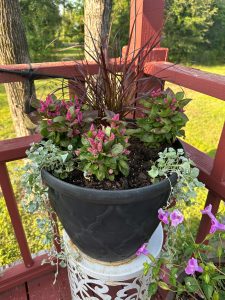For those of us that don’t have the best landscape conditions or the time, money, or inclination to invest into a vibrant yard display of annual flowers, growing our flowers in containers is a great option! Growing in containers has several advantages over growing flowers in the ground. It gives gardeners control over the soil, fertility, and water conditions that the plants are grown in and the ability to add pops of color/texture anywhere – in an existing planting bed, patio, deck, porch, or even indoors. Let’s explore some simple tips to create containers that will offer low-maintenance explosions of color all summer long.
The easiest way to create full, colorful containers is by using the design scheme known as the “thriller, filler, spiller” arrangement. This design first utilizes a dramatic “thriller” in the back of the container, usually a plant that has a taller, upright growth habit and striking flowers or foliage. Commonly used thrillers are plants like Purple Fountain Grass, Salvia, Canna, and Hawaiian Ti. Next come the fillers. Fillers are plants that possess a mounding habit and generally provide the floral firepower in the container. Popular fillers include Vinca, Begonia, ‘Diamond Frost’ Euphorbia, Lantana, Pentas, Impatiens (for shady containers), and even foliage plants like Coleus, Caladiums, and Ferns. Finally, spillers round out the containers by “spilling” over the sides. These are typically vining or trailing plants and add a final dramatic touch to the overall container style. Some of my most-used spiller plants are Creeping Jenny, ‘Silver Falls’ Dichondra, ‘Gold Dust’ Mecardonia, Torenia (aka Wishbone Flower), and Sweet Potato Vine.

Example container using a thriller (Purple Fountain Grass), filler (Celosia), and spiller (‘Silver Falls’ Dichondra). Photo courtesy of Daniel Leonard.
Will all those plant options, how does one choose plants to combine in containers? When perusing the nursery to pick thriller, filler, and spiller plants, all you need to remember to be successful is the basic layout of the color wheel and the phrase “right plant, right place”. Knowing the color wheel is important because some colors look better than others in combination! For instance, most classic color combos are known as “contrasting colors”, just meaning opposite each other on the color wheel – think the Orange and Blue of the Florida Gators or the Purple and Gold of the LSU Tigers. It’s hard to go wrong pairing plants of contrasting foliage or flower colors. Another option is to use different shades or hues of the same color, this is known as a monochromatic color arrangement. Monochromatic arrangements create a stunning punch of color and can even be used to highlight colors or features around the container, like the brick or siding color of your home.
After choosing your color palette, it’s critical to make sure you have the right plant in the right place. For container gardening, this just means pairing plants with like needs. For instance, you wouldn’t want to grow shade loving Impatiens in the same container as sun loving Purple Fountain Grass. Likewise, pairing a succulent with a heavy water user like Coleus is a bad idea. Combine plants with like growing condition preferences and you’ll save yourself a major gardening headache!
Maintaining your summer containers is also relatively easy. At planting, fertilize with a slow-release fertilizer like Osmocote or other similar product at the label rate and water in. After the first month or so, I begin supplemental fertilizing every couple of weeks with a liquid fertilizer. As your container grows, the days get hotter, and there are more roots to suck up water, your watering frequency will increase from once every couple of days to every day, and, on very hot days, twice a day (morning and late afternoon/evening). All this watering and fertilizing sounds like a lot of work, but I enjoy getting out and spending a few minutes with my plants! It’s a great way to start your day/wind down after work and allows you to spot any issues before they become major problems!
Gardening with containers is without a doubt the easiest way to create summer long color on your deck, patio, or landscape. Giving us the ability to control soil, water, sun, and fertilizer conditions, growing our annual color in containers removes many of the variables that makes gardening difficult and provides pops of color and texture in any setting – design and plant a few containers this summer! For more questions about container gardening or any other horticultural topic, contact us at the UF/IFAS Calhoun County Extension office. Happy gardening this summer!
- Mulch is a Must in Your Landscape - December 4, 2025
- Tis the Season – Why Winter is the Best Time to Plant Trees and Shrubs - November 26, 2025
- Feeling Blue (Ginger) This Fall - November 13, 2025
